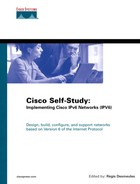Summary
During the transition period, integration and coexistence mechanisms maintain complete backward compatibility with the IPv4 protocol and IPv4-only networks. This chapter examined three classes of integration and coexistence strategies—dual stack, tunneling, and protocol translation.
Dual stack allows nodes on the network to handle simultaneously an IPv4 stack and an IPv6 stack. In this context, the naming service (Domain Name System) provides information to dual-stack nodes to force the selection of a stack.
You learned how tunnels carry IPv6 packets over existing IPv4 networks. You explored the main tunneling techniques available for the deployment and establishment of tunnels over IPv4. The following are the key protocols and techniques defined by the IETF for the establishment of tunnels between dual-stack nodes:
Configured tunnel— Tunnels are configured manually between dual-stack nodes to carry IPv6 packets over IPv4.
Tunnel broker and tunnel server— Tunnel broker and tunnel server are mechanisms to automate the deployment of configured tunnels.
6to4— Tunnels are dynamically established between 6to4 sites. The IPv4 address of the 6to4 router is embedded in the 6to4 prefix of the 6to4 sites.
GRE tunnel— Tunneling IPv6 packets in a GRE tunnel is another method to carry IPv6 packets over IPv4 networks. However, the deployment of GRE tunnels is done statically, as for configured tunnels.
ISATAP— Tunnels are dynamically established within a domain to create one virtual IPv6 network over IPv4. Prefixes and addresses assigned to ISATAP hosts and ISATAP routers are based on a specific format.
Automatic IPv4-compatible tunnel— Allows isolated hosts on an IPv4 network to automatically establish tunnels over IPv4 to isolated hosts. This mechanism has several limitations and is being deprecated.
Teredo tunnel— Tunnels to carry IPv6 packets over IPv4 can be established through Network Address Translation (NAT) devices over IPv4 UDP packets. The Teredo tunnel must be initiated by the Teredo clients that are behind a NAT in IPv4 domains.
You also learned how IPv6-only nodes can interact with IPv4-only nodes using Application-Level Gateway (ALG) and NAT-PT. NAT-PT can be used to do protocol translations between the IPv6-only domain and the IPv4-only domain when no other methods are available. The IETF also defined other translation mechanisms that may be used in specific contexts such as TCP-UDP Relay, Bump in the Stack (BIS), Dual-Stack Transition Mechanism (DSTM), and the SOCKS-based IPv6/IPv4 gateway.
Although several mechanisms allow the integration and coexistence of IPv6 and IPv4, infrastructures made of native IPv6 networks and links should be preferred before any of these mechanisms.
Finally, you learned how to configure dual stack, configured tunnel, 6to4, GRE tunnel, ISATAP, and NAT-PT on the Cisco IOS Software to deploy an IPv6 network that interacts with your current IPv4 infrastructure. You also saw examples, router configurations, and Cisco IOS Software commands that manage these mechanisms on the Cisco technology.
